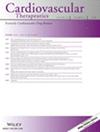急性冠脉综合征患者血浆三甲胺- n -氧化物与动脉粥样硬化的正相关
摘要
目的:动脉粥样硬化是急性冠状动脉综合征(ACS)的主要病因,是世界范围内发病率和死亡率的重要因素。微生物衍生的代谢物三甲胺- n -氧化物(TMAO)作为动脉粥样硬化的危险因素引起了极大的兴趣和争议。因此,在本研究中,我们旨在探讨血浆TMAO是否可能是ACS患者冠状动脉粥样硬化的危险因素,以及这与血浆中脂质和促炎细胞因子的关系。方法:我们招募了连续接受经皮冠状动脉介入治疗(PCI)的ACS患者。采用Gensini评分法评价患者冠状动脉血管造影动脉粥样硬化。低度组(Gensini评分< 25)13例,中度组(Gensini评分25-50)33例,重度组(Gensini评分≥50)81例。临床生化检测血浆TMAO、血管炎因子、心血管生物标志物,彩色多普勒超声检测颈动脉内膜-中膜厚度(IMT), PCI评估冠状动脉粥样硬化病变。结果:血浆TMAO浓度与Gensini评分(OR = 0.629, p < 0.001)和Gensini亚组(R = 0.604, p < 0.001)呈正相关。重度冠状动脉粥样硬化患者血浆TMAO浓度高于中度冠状动脉粥样硬化患者,中度冠状动脉粥样硬化患者血浆TMAO浓度高于轻度冠状动脉粥样硬化患者,差异均有统计学意义[4.73 (3.13,4.62)vs . 1.13 (0.63, 3.34) vs . 0.79 (0.20, 1.29), p < 0.001]。此外,ROC分析显示血浆TMAO可以识别动脉粥样硬化的严重程度(p < 0.001)。重度动脉粥样硬化患者TMAO的AUC为0.852 (95%CI = 0.779 ~ 0.925)。当TMAO临界值为1.2715 pg/ml时,TMAO识别严重动脉粥样硬化的敏感性和特异性分别为96.3%和63.0%。此外,logistic回归分析显示血浆TMAO浓度与冠状动脉粥样硬化严重程度呈正相关(OR = 1.934, 95%CI = 1.522 ~ 2.459, p < 0.001)。TMAO与年龄(OR = -0.224, p < 0.05)、b型利钠肽(OR = -0.175, p < 0.05)、白细胞介素-8 (OR = -0.324, p < 0.001)呈负相关,与一氧化氮(NO)呈正相关(OR = 0.234, p < 0.01)。然而,Gensini评分与心血管生物标志物、血管炎因子和颈动脉IMT之间没有明显的相关性。结论:我们的横断面观察表明血浆TMAO浓度与ACS患者冠状动脉粥样硬化呈正相关,是严重动脉粥样硬化的危险因素。血浆TMAO还与年龄、BNP、IL-8和NO相关。然而,本研究未发现动脉粥样硬化与血管炎因子和心血管生物标志物之间存在明显关联,也没有确凿证据表明氧化三甲胺通过调节炎症或脂质来增强动脉粥样硬化。

Aim. Atherosclerosis is the major cause of acute coronary syndrome (ACS) which is a significant contributor to both morbidity and mortality in the world. The microbiome-derived metabolite trimethylamine-N-oxide (TMAO) has aroused great interest and controversy as a risk factor of atherosclerosis. Therefore, in this study, we aimed at investigating whether plasma TMAO can be a risk factor of atherosclerosis in coronary artery of patients with ACS and how this relates to lipids and proinflammatory cytokines in plasma. Methods. We enrolled consecutive patients with ACS who underwent percutaneous coronary intervention (PCI). Gensini scoring was used to evaluate angiographic atherosclerosis in the coronary artery of the patients. 13 patients were divided into low (Gensini score < 25), 33 into intermediate (Gensini score 25-50), and 81 into severe atherosclerosis (Gensini score ≥50). Plasma TMAO, vasculitis factors, and cardiovascular biomarkers were measured by clinical biochemistry, intima-media thickness (IMT) of carotid artery was determined by the Color Doppler ultrasound, and the atherosclerotic lesion in coronary artery was assessed in PCI. Results. Plasma TMAO concentrations were positively associated with Gensini score (OR = 0.629, p < 0.001) and Gensini subgroup (R = 0.604, p < 0.001). Plasma TMAO concentrations in patients with severe coronary atherosclerosis were higher than those of patients with moderate coronary atherosclerosis, and the plasma TMAO concentrations of patients with moderate coronary atherosclerosis were higher than those of patients with mild coronary atherosclerosis, the difference was statistically significant [4.73 (3.13, 4.62) versus 1.13 (0.63, 3.34) versus 0.79 (0.20, 1.29), p < 0.001], respectively. Furthermore, ROC analysis showed that plasma TMAO could identify the severity of atherosclerosis (p < 0.001). The AUC of TMAO for severe atherosclerosis was 0.852 (95%CI = 0.779 − 0.925). The sensitivity and specificity of TMAO for identifying severe atherosclerosis are 96.3% and 63.0% when the cut-off value of TMAO was set at 1.2715 pg/ml. Furthermore, logistic regression analysis showed plasma TMAO concentrations were positively associated with severity of atherosclerosis in coronary artery (OR = 1.934, 95%CI = 1.522 − 2.459, p < 0.001). For all that, negatively association was observed between TMAO and age (OR = −0.224, p < 0.05), B-type natriuretic peptide (BNP) (OR = −0.175, p < 0.05), and interleukin-8 (IL-8) (OR = −0.324, p < 0.001), while positive association was observed between TMAO and nitric oxide (NO) (OR = 0.234, p < 0.01). However, there is no obvious association was observed between Gensini score and cardiovascular biomarkers, vasculitis factors, and carotid IMT, respectively. Conclusion. Our cross-sectional observation suggested that plasma TMAO concentrations positively associated with coronary atherosclerosis in ACS patients and serve as a risk factor for severe atherosclerosis. Plasma TMAO also correlated with age, BNP, IL-8, and NO. However, no obvious association was found between atherosclerosis with vasculitis factors and cardiovascular biomarkers in this study, and there was no conclusive evidence showing TMAO enhance atherosclerosis via regulation of inflammation or lipid.

 求助内容:
求助内容: 应助结果提醒方式:
应助结果提醒方式:


